Analysis of Civil Engineering Project Management and Success Factors
VerifiedAdded on 2023/06/04
|10
|2110
|496
Report
AI Summary
This report delves into the management of civil engineering projects, exploring critical elements for project success, the significance of cost planning, and the influence of project teams. It examines the Adelaide-Darwin railway project as a case study, highlighting factors such as technical performance, efficiency, innovation, and business outcomes. The report emphasizes the role of cost managers in overseeing project finances and ensuring quality and safety standards. It also discusses the importance of cost planning in determining project feasibility, securing funding, and allocating resources. Furthermore, the report analyzes the impact of project teams on corrective and preventive measures, as well as risk management strategies including financing, resource management, and procurement. The conclusion underscores the importance of meticulous planning and effective strategies for successful project completion.
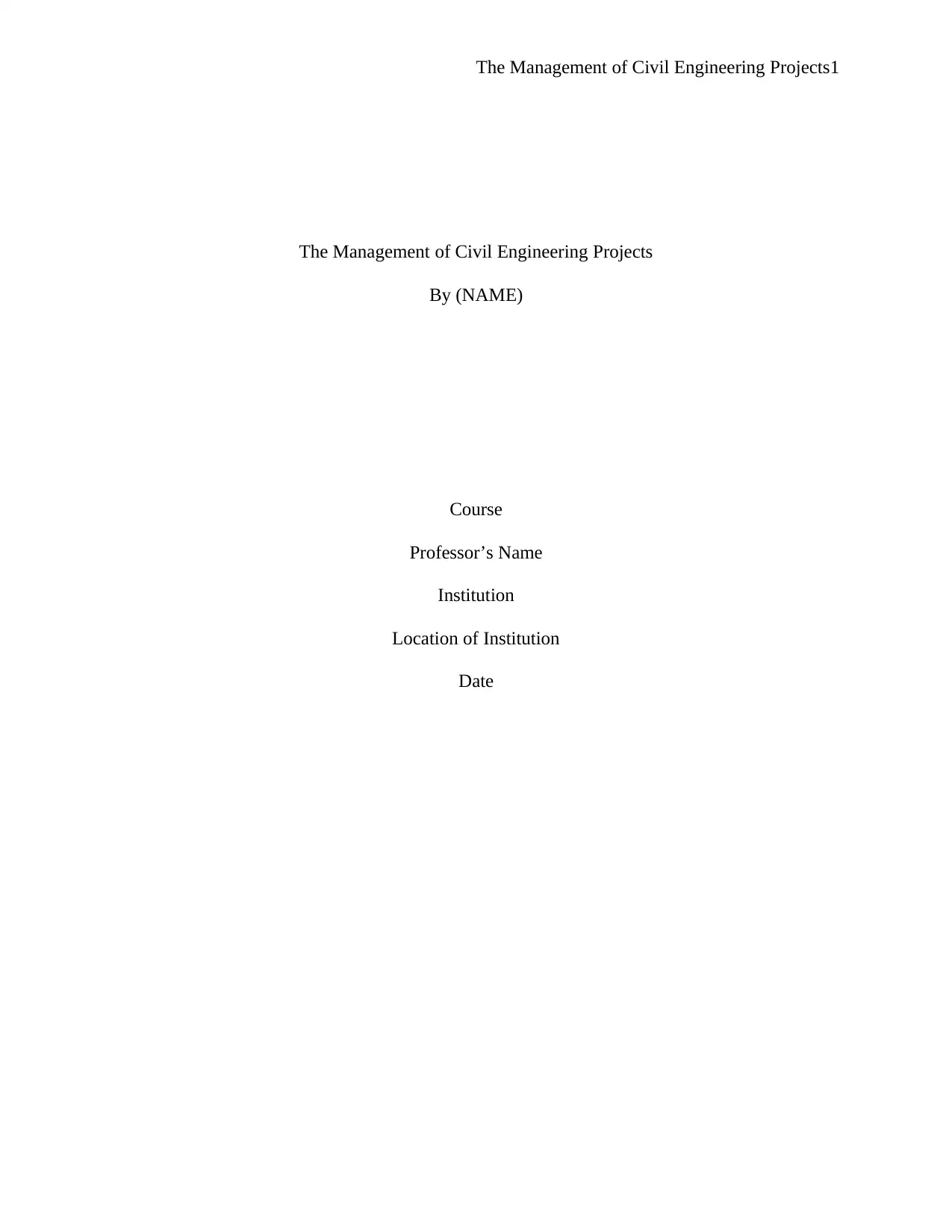
The Management of Civil Engineering Projects1
The Management of Civil Engineering Projects
By (NAME)
Course
Professor’s Name
Institution
Location of Institution
Date
The Management of Civil Engineering Projects
By (NAME)
Course
Professor’s Name
Institution
Location of Institution
Date
Paraphrase This Document
Need a fresh take? Get an instant paraphrase of this document with our AI Paraphraser
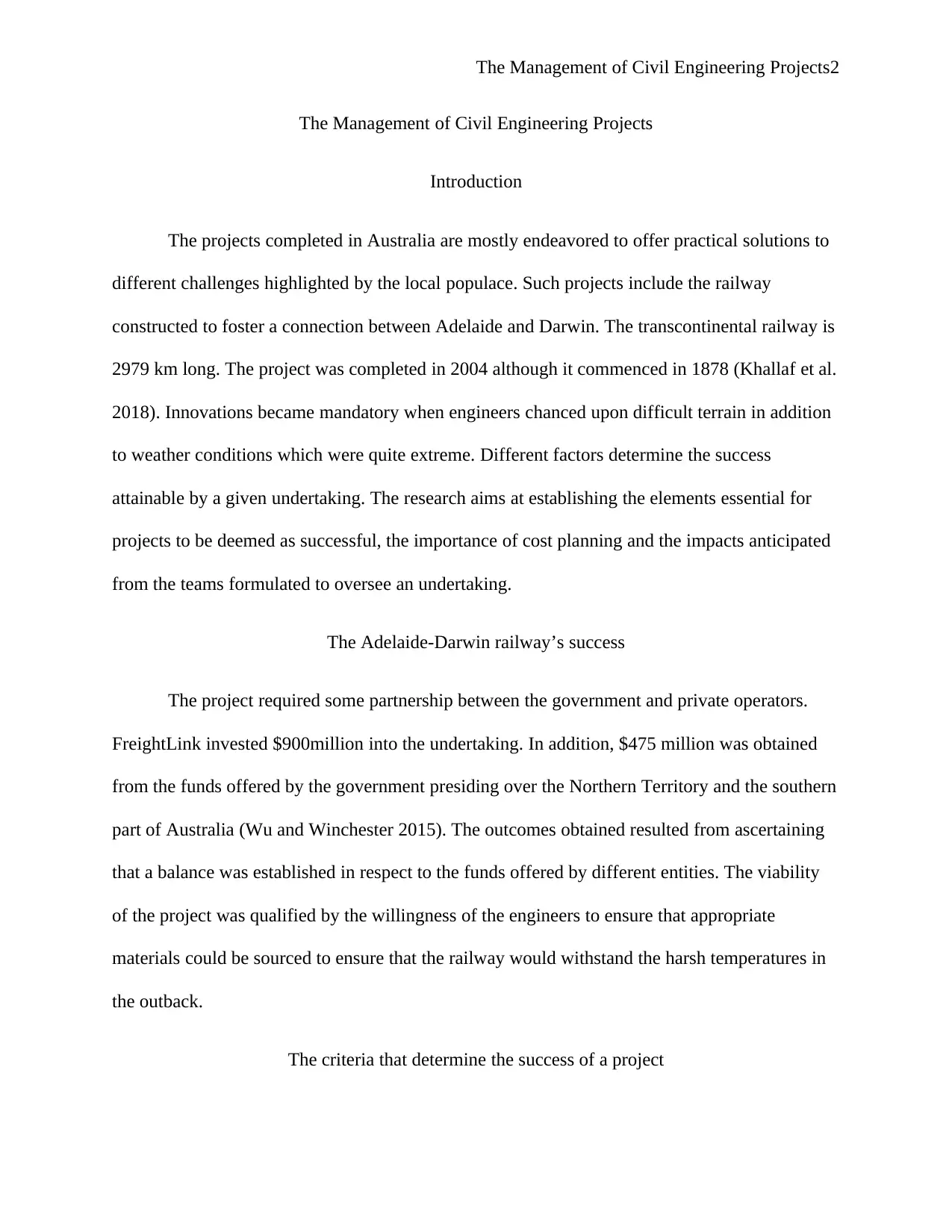
The Management of Civil Engineering Projects2
The Management of Civil Engineering Projects
Introduction
The projects completed in Australia are mostly endeavored to offer practical solutions to
different challenges highlighted by the local populace. Such projects include the railway
constructed to foster a connection between Adelaide and Darwin. The transcontinental railway is
2979 km long. The project was completed in 2004 although it commenced in 1878 (Khallaf et al.
2018). Innovations became mandatory when engineers chanced upon difficult terrain in addition
to weather conditions which were quite extreme. Different factors determine the success
attainable by a given undertaking. The research aims at establishing the elements essential for
projects to be deemed as successful, the importance of cost planning and the impacts anticipated
from the teams formulated to oversee an undertaking.
The Adelaide-Darwin railway’s success
The project required some partnership between the government and private operators.
FreightLink invested $900million into the undertaking. In addition, $475 million was obtained
from the funds offered by the government presiding over the Northern Territory and the southern
part of Australia (Wu and Winchester 2015). The outcomes obtained resulted from ascertaining
that a balance was established in respect to the funds offered by different entities. The viability
of the project was qualified by the willingness of the engineers to ensure that appropriate
materials could be sourced to ensure that the railway would withstand the harsh temperatures in
the outback.
The criteria that determine the success of a project
The Management of Civil Engineering Projects
Introduction
The projects completed in Australia are mostly endeavored to offer practical solutions to
different challenges highlighted by the local populace. Such projects include the railway
constructed to foster a connection between Adelaide and Darwin. The transcontinental railway is
2979 km long. The project was completed in 2004 although it commenced in 1878 (Khallaf et al.
2018). Innovations became mandatory when engineers chanced upon difficult terrain in addition
to weather conditions which were quite extreme. Different factors determine the success
attainable by a given undertaking. The research aims at establishing the elements essential for
projects to be deemed as successful, the importance of cost planning and the impacts anticipated
from the teams formulated to oversee an undertaking.
The Adelaide-Darwin railway’s success
The project required some partnership between the government and private operators.
FreightLink invested $900million into the undertaking. In addition, $475 million was obtained
from the funds offered by the government presiding over the Northern Territory and the southern
part of Australia (Wu and Winchester 2015). The outcomes obtained resulted from ascertaining
that a balance was established in respect to the funds offered by different entities. The viability
of the project was qualified by the willingness of the engineers to ensure that appropriate
materials could be sourced to ensure that the railway would withstand the harsh temperatures in
the outback.
The criteria that determine the success of a project
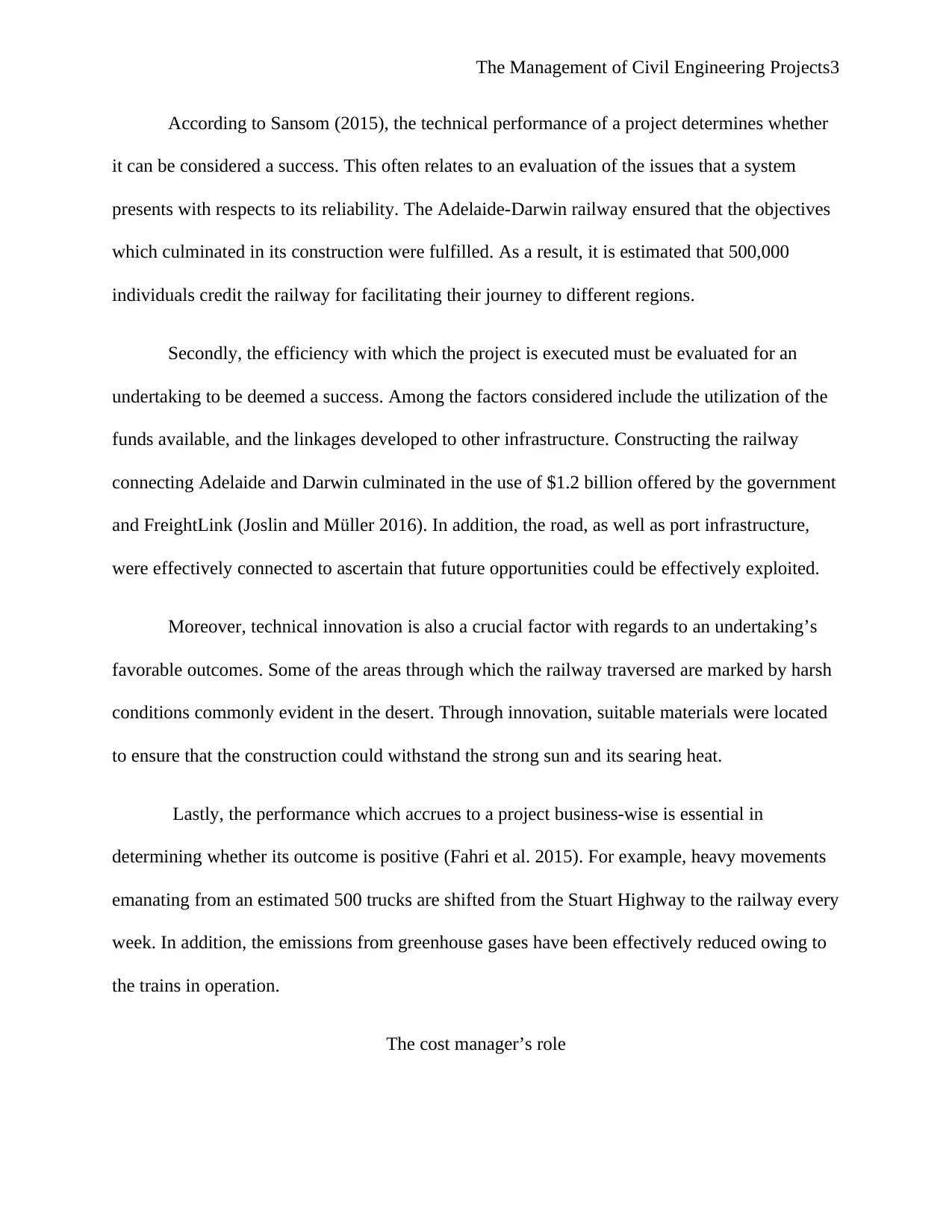
The Management of Civil Engineering Projects3
According to Sansom (2015), the technical performance of a project determines whether
it can be considered a success. This often relates to an evaluation of the issues that a system
presents with respects to its reliability. The Adelaide-Darwin railway ensured that the objectives
which culminated in its construction were fulfilled. As a result, it is estimated that 500,000
individuals credit the railway for facilitating their journey to different regions.
Secondly, the efficiency with which the project is executed must be evaluated for an
undertaking to be deemed a success. Among the factors considered include the utilization of the
funds available, and the linkages developed to other infrastructure. Constructing the railway
connecting Adelaide and Darwin culminated in the use of $1.2 billion offered by the government
and FreightLink (Joslin and Müller 2016). In addition, the road, as well as port infrastructure,
were effectively connected to ascertain that future opportunities could be effectively exploited.
Moreover, technical innovation is also a crucial factor with regards to an undertaking’s
favorable outcomes. Some of the areas through which the railway traversed are marked by harsh
conditions commonly evident in the desert. Through innovation, suitable materials were located
to ensure that the construction could withstand the strong sun and its searing heat.
Lastly, the performance which accrues to a project business-wise is essential in
determining whether its outcome is positive (Fahri et al. 2015). For example, heavy movements
emanating from an estimated 500 trucks are shifted from the Stuart Highway to the railway every
week. In addition, the emissions from greenhouse gases have been effectively reduced owing to
the trains in operation.
The cost manager’s role
According to Sansom (2015), the technical performance of a project determines whether
it can be considered a success. This often relates to an evaluation of the issues that a system
presents with respects to its reliability. The Adelaide-Darwin railway ensured that the objectives
which culminated in its construction were fulfilled. As a result, it is estimated that 500,000
individuals credit the railway for facilitating their journey to different regions.
Secondly, the efficiency with which the project is executed must be evaluated for an
undertaking to be deemed a success. Among the factors considered include the utilization of the
funds available, and the linkages developed to other infrastructure. Constructing the railway
connecting Adelaide and Darwin culminated in the use of $1.2 billion offered by the government
and FreightLink (Joslin and Müller 2016). In addition, the road, as well as port infrastructure,
were effectively connected to ascertain that future opportunities could be effectively exploited.
Moreover, technical innovation is also a crucial factor with regards to an undertaking’s
favorable outcomes. Some of the areas through which the railway traversed are marked by harsh
conditions commonly evident in the desert. Through innovation, suitable materials were located
to ensure that the construction could withstand the strong sun and its searing heat.
Lastly, the performance which accrues to a project business-wise is essential in
determining whether its outcome is positive (Fahri et al. 2015). For example, heavy movements
emanating from an estimated 500 trucks are shifted from the Stuart Highway to the railway every
week. In addition, the emissions from greenhouse gases have been effectively reduced owing to
the trains in operation.
The cost manager’s role
⊘ This is a preview!⊘
Do you want full access?
Subscribe today to unlock all pages.

Trusted by 1+ million students worldwide
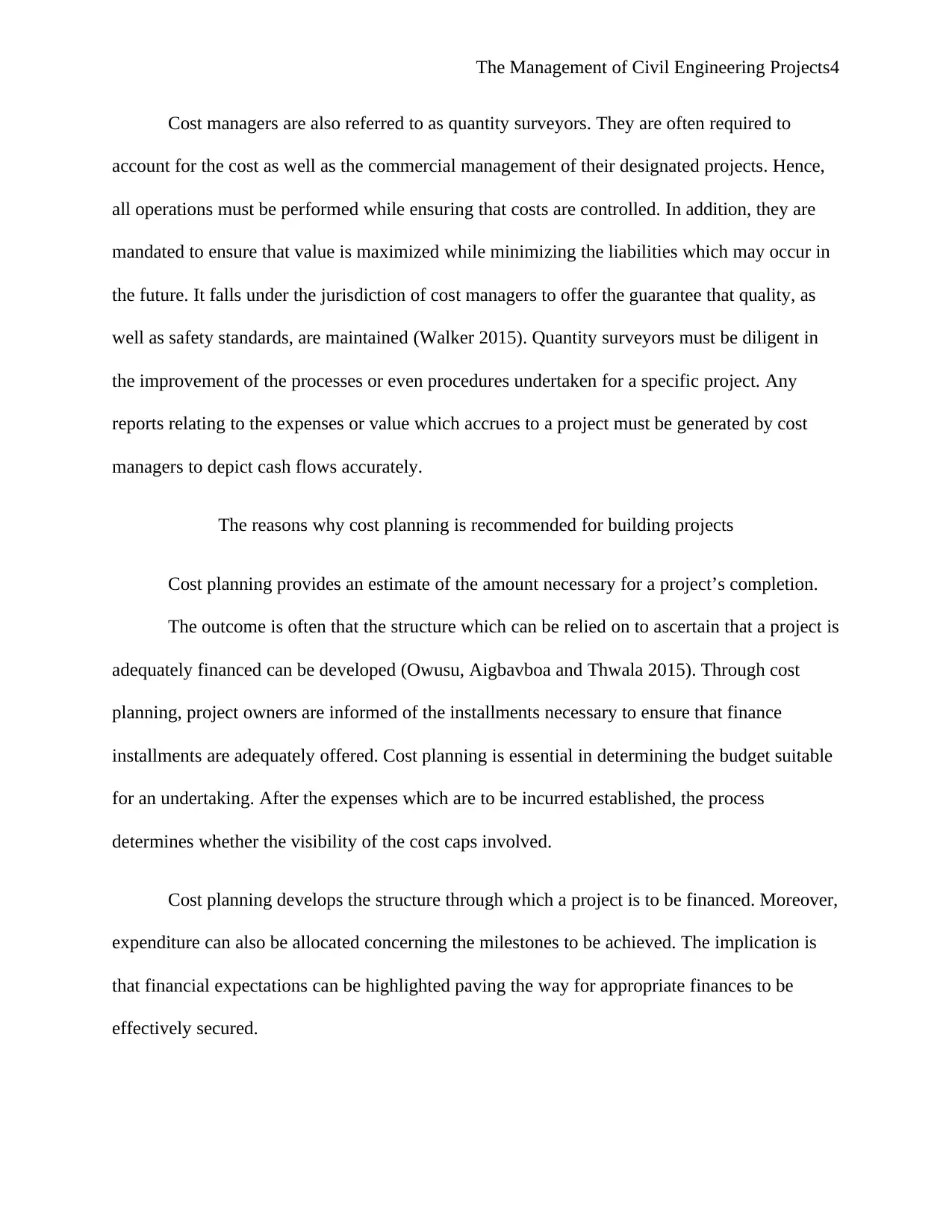
The Management of Civil Engineering Projects4
Cost managers are also referred to as quantity surveyors. They are often required to
account for the cost as well as the commercial management of their designated projects. Hence,
all operations must be performed while ensuring that costs are controlled. In addition, they are
mandated to ensure that value is maximized while minimizing the liabilities which may occur in
the future. It falls under the jurisdiction of cost managers to offer the guarantee that quality, as
well as safety standards, are maintained (Walker 2015). Quantity surveyors must be diligent in
the improvement of the processes or even procedures undertaken for a specific project. Any
reports relating to the expenses or value which accrues to a project must be generated by cost
managers to depict cash flows accurately.
The reasons why cost planning is recommended for building projects
Cost planning provides an estimate of the amount necessary for a project’s completion.
The outcome is often that the structure which can be relied on to ascertain that a project is
adequately financed can be developed (Owusu, Aigbavboa and Thwala 2015). Through cost
planning, project owners are informed of the installments necessary to ensure that finance
installments are adequately offered. Cost planning is essential in determining the budget suitable
for an undertaking. After the expenses which are to be incurred established, the process
determines whether the visibility of the cost caps involved.
Cost planning develops the structure through which a project is to be financed. Moreover,
expenditure can also be allocated concerning the milestones to be achieved. The implication is
that financial expectations can be highlighted paving the way for appropriate finances to be
effectively secured.
Cost managers are also referred to as quantity surveyors. They are often required to
account for the cost as well as the commercial management of their designated projects. Hence,
all operations must be performed while ensuring that costs are controlled. In addition, they are
mandated to ensure that value is maximized while minimizing the liabilities which may occur in
the future. It falls under the jurisdiction of cost managers to offer the guarantee that quality, as
well as safety standards, are maintained (Walker 2015). Quantity surveyors must be diligent in
the improvement of the processes or even procedures undertaken for a specific project. Any
reports relating to the expenses or value which accrues to a project must be generated by cost
managers to depict cash flows accurately.
The reasons why cost planning is recommended for building projects
Cost planning provides an estimate of the amount necessary for a project’s completion.
The outcome is often that the structure which can be relied on to ascertain that a project is
adequately financed can be developed (Owusu, Aigbavboa and Thwala 2015). Through cost
planning, project owners are informed of the installments necessary to ensure that finance
installments are adequately offered. Cost planning is essential in determining the budget suitable
for an undertaking. After the expenses which are to be incurred established, the process
determines whether the visibility of the cost caps involved.
Cost planning develops the structure through which a project is to be financed. Moreover,
expenditure can also be allocated concerning the milestones to be achieved. The implication is
that financial expectations can be highlighted paving the way for appropriate finances to be
effectively secured.
Paraphrase This Document
Need a fresh take? Get an instant paraphrase of this document with our AI Paraphraser
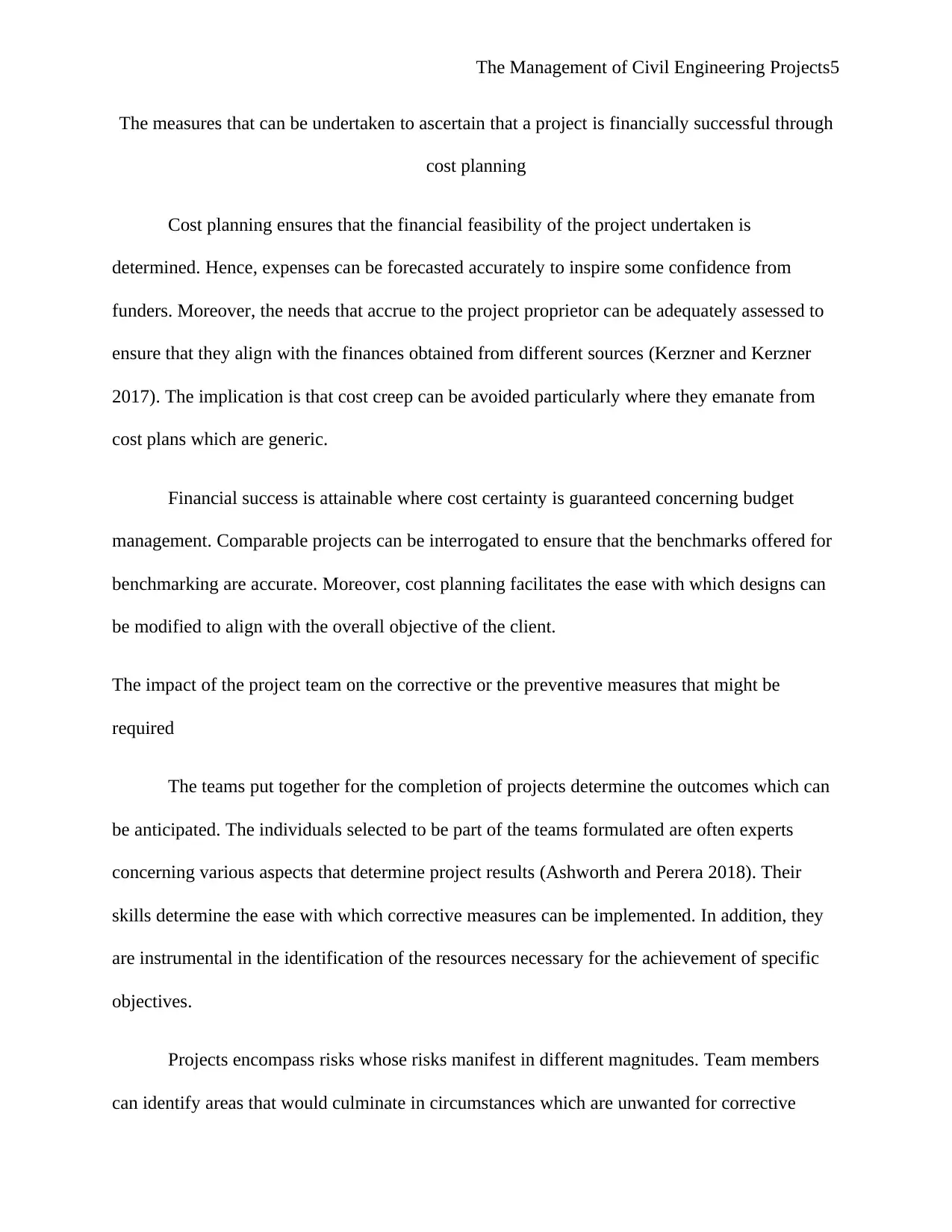
The Management of Civil Engineering Projects5
The measures that can be undertaken to ascertain that a project is financially successful through
cost planning
Cost planning ensures that the financial feasibility of the project undertaken is
determined. Hence, expenses can be forecasted accurately to inspire some confidence from
funders. Moreover, the needs that accrue to the project proprietor can be adequately assessed to
ensure that they align with the finances obtained from different sources (Kerzner and Kerzner
2017). The implication is that cost creep can be avoided particularly where they emanate from
cost plans which are generic.
Financial success is attainable where cost certainty is guaranteed concerning budget
management. Comparable projects can be interrogated to ensure that the benchmarks offered for
benchmarking are accurate. Moreover, cost planning facilitates the ease with which designs can
be modified to align with the overall objective of the client.
The impact of the project team on the corrective or the preventive measures that might be
required
The teams put together for the completion of projects determine the outcomes which can
be anticipated. The individuals selected to be part of the teams formulated are often experts
concerning various aspects that determine project results (Ashworth and Perera 2018). Their
skills determine the ease with which corrective measures can be implemented. In addition, they
are instrumental in the identification of the resources necessary for the achievement of specific
objectives.
Projects encompass risks whose risks manifest in different magnitudes. Team members
can identify areas that would culminate in circumstances which are unwanted for corrective
The measures that can be undertaken to ascertain that a project is financially successful through
cost planning
Cost planning ensures that the financial feasibility of the project undertaken is
determined. Hence, expenses can be forecasted accurately to inspire some confidence from
funders. Moreover, the needs that accrue to the project proprietor can be adequately assessed to
ensure that they align with the finances obtained from different sources (Kerzner and Kerzner
2017). The implication is that cost creep can be avoided particularly where they emanate from
cost plans which are generic.
Financial success is attainable where cost certainty is guaranteed concerning budget
management. Comparable projects can be interrogated to ensure that the benchmarks offered for
benchmarking are accurate. Moreover, cost planning facilitates the ease with which designs can
be modified to align with the overall objective of the client.
The impact of the project team on the corrective or the preventive measures that might be
required
The teams put together for the completion of projects determine the outcomes which can
be anticipated. The individuals selected to be part of the teams formulated are often experts
concerning various aspects that determine project results (Ashworth and Perera 2018). Their
skills determine the ease with which corrective measures can be implemented. In addition, they
are instrumental in the identification of the resources necessary for the achievement of specific
objectives.
Projects encompass risks whose risks manifest in different magnitudes. Team members
can identify areas that would culminate in circumstances which are unwanted for corrective
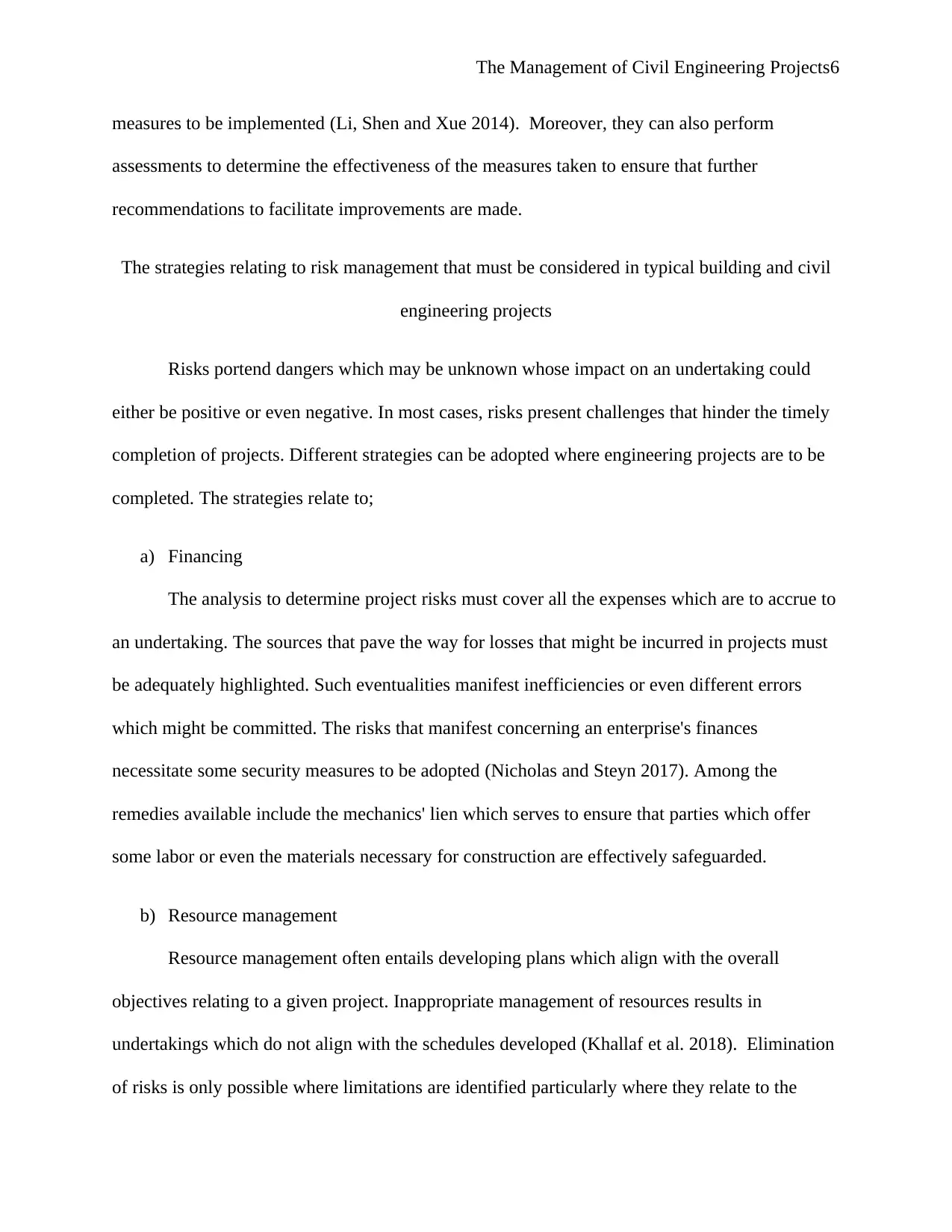
The Management of Civil Engineering Projects6
measures to be implemented (Li, Shen and Xue 2014). Moreover, they can also perform
assessments to determine the effectiveness of the measures taken to ensure that further
recommendations to facilitate improvements are made.
The strategies relating to risk management that must be considered in typical building and civil
engineering projects
Risks portend dangers which may be unknown whose impact on an undertaking could
either be positive or even negative. In most cases, risks present challenges that hinder the timely
completion of projects. Different strategies can be adopted where engineering projects are to be
completed. The strategies relate to;
a) Financing
The analysis to determine project risks must cover all the expenses which are to accrue to
an undertaking. The sources that pave the way for losses that might be incurred in projects must
be adequately highlighted. Such eventualities manifest inefficiencies or even different errors
which might be committed. The risks that manifest concerning an enterprise's finances
necessitate some security measures to be adopted (Nicholas and Steyn 2017). Among the
remedies available include the mechanics' lien which serves to ensure that parties which offer
some labor or even the materials necessary for construction are effectively safeguarded.
b) Resource management
Resource management often entails developing plans which align with the overall
objectives relating to a given project. Inappropriate management of resources results in
undertakings which do not align with the schedules developed (Khallaf et al. 2018). Elimination
of risks is only possible where limitations are identified particularly where they relate to the
measures to be implemented (Li, Shen and Xue 2014). Moreover, they can also perform
assessments to determine the effectiveness of the measures taken to ensure that further
recommendations to facilitate improvements are made.
The strategies relating to risk management that must be considered in typical building and civil
engineering projects
Risks portend dangers which may be unknown whose impact on an undertaking could
either be positive or even negative. In most cases, risks present challenges that hinder the timely
completion of projects. Different strategies can be adopted where engineering projects are to be
completed. The strategies relate to;
a) Financing
The analysis to determine project risks must cover all the expenses which are to accrue to
an undertaking. The sources that pave the way for losses that might be incurred in projects must
be adequately highlighted. Such eventualities manifest inefficiencies or even different errors
which might be committed. The risks that manifest concerning an enterprise's finances
necessitate some security measures to be adopted (Nicholas and Steyn 2017). Among the
remedies available include the mechanics' lien which serves to ensure that parties which offer
some labor or even the materials necessary for construction are effectively safeguarded.
b) Resource management
Resource management often entails developing plans which align with the overall
objectives relating to a given project. Inappropriate management of resources results in
undertakings which do not align with the schedules developed (Khallaf et al. 2018). Elimination
of risks is only possible where limitations are identified particularly where they relate to the
⊘ This is a preview!⊘
Do you want full access?
Subscribe today to unlock all pages.

Trusted by 1+ million students worldwide
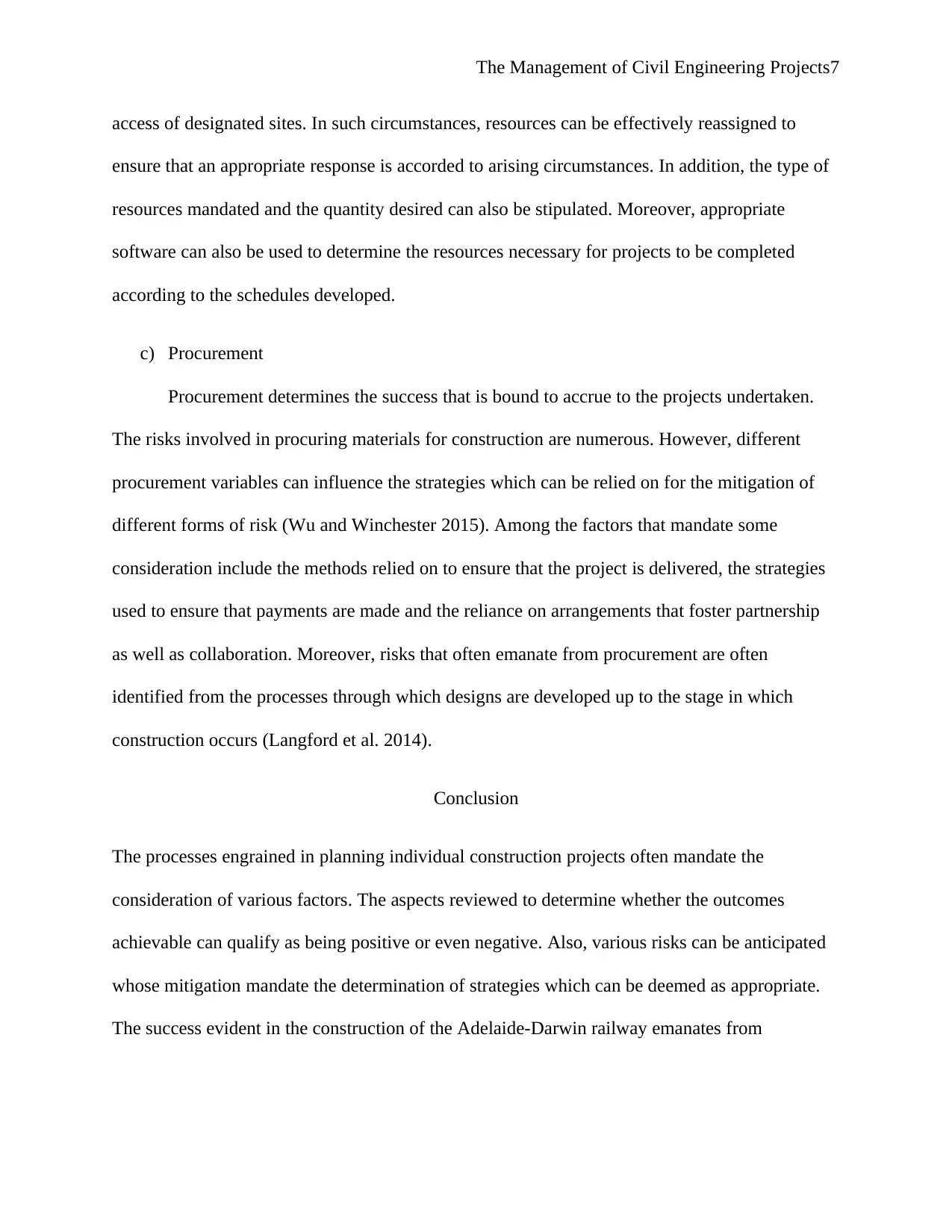
The Management of Civil Engineering Projects7
access of designated sites. In such circumstances, resources can be effectively reassigned to
ensure that an appropriate response is accorded to arising circumstances. In addition, the type of
resources mandated and the quantity desired can also be stipulated. Moreover, appropriate
software can also be used to determine the resources necessary for projects to be completed
according to the schedules developed.
c) Procurement
Procurement determines the success that is bound to accrue to the projects undertaken.
The risks involved in procuring materials for construction are numerous. However, different
procurement variables can influence the strategies which can be relied on for the mitigation of
different forms of risk (Wu and Winchester 2015). Among the factors that mandate some
consideration include the methods relied on to ensure that the project is delivered, the strategies
used to ensure that payments are made and the reliance on arrangements that foster partnership
as well as collaboration. Moreover, risks that often emanate from procurement are often
identified from the processes through which designs are developed up to the stage in which
construction occurs (Langford et al. 2014).
Conclusion
The processes engrained in planning individual construction projects often mandate the
consideration of various factors. The aspects reviewed to determine whether the outcomes
achievable can qualify as being positive or even negative. Also, various risks can be anticipated
whose mitigation mandate the determination of strategies which can be deemed as appropriate.
The success evident in the construction of the Adelaide-Darwin railway emanates from
access of designated sites. In such circumstances, resources can be effectively reassigned to
ensure that an appropriate response is accorded to arising circumstances. In addition, the type of
resources mandated and the quantity desired can also be stipulated. Moreover, appropriate
software can also be used to determine the resources necessary for projects to be completed
according to the schedules developed.
c) Procurement
Procurement determines the success that is bound to accrue to the projects undertaken.
The risks involved in procuring materials for construction are numerous. However, different
procurement variables can influence the strategies which can be relied on for the mitigation of
different forms of risk (Wu and Winchester 2015). Among the factors that mandate some
consideration include the methods relied on to ensure that the project is delivered, the strategies
used to ensure that payments are made and the reliance on arrangements that foster partnership
as well as collaboration. Moreover, risks that often emanate from procurement are often
identified from the processes through which designs are developed up to the stage in which
construction occurs (Langford et al. 2014).
Conclusion
The processes engrained in planning individual construction projects often mandate the
consideration of various factors. The aspects reviewed to determine whether the outcomes
achievable can qualify as being positive or even negative. Also, various risks can be anticipated
whose mitigation mandate the determination of strategies which can be deemed as appropriate.
The success evident in the construction of the Adelaide-Darwin railway emanates from
Paraphrase This Document
Need a fresh take? Get an instant paraphrase of this document with our AI Paraphraser

The Management of Civil Engineering Projects8
meticulous planning and the implementation of strategies geared towards its efficient
completion.
meticulous planning and the implementation of strategies geared towards its efficient
completion.
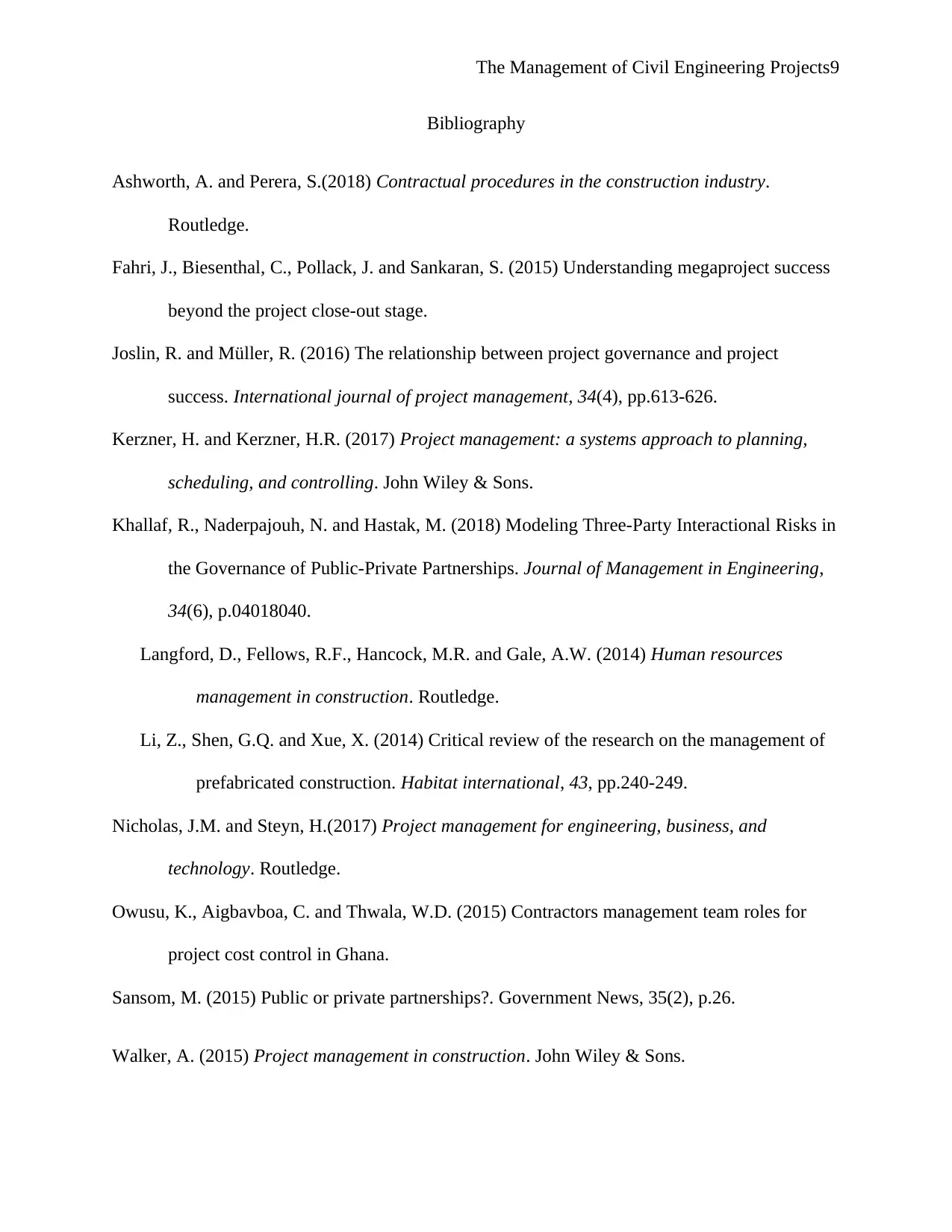
The Management of Civil Engineering Projects9
Bibliography
Ashworth, A. and Perera, S.(2018) Contractual procedures in the construction industry.
Routledge.
Fahri, J., Biesenthal, C., Pollack, J. and Sankaran, S. (2015) Understanding megaproject success
beyond the project close-out stage.
Joslin, R. and Müller, R. (2016) The relationship between project governance and project
success. International journal of project management, 34(4), pp.613-626.
Kerzner, H. and Kerzner, H.R. (2017) Project management: a systems approach to planning,
scheduling, and controlling. John Wiley & Sons.
Khallaf, R., Naderpajouh, N. and Hastak, M. (2018) Modeling Three-Party Interactional Risks in
the Governance of Public-Private Partnerships. Journal of Management in Engineering,
34(6), p.04018040.
Langford, D., Fellows, R.F., Hancock, M.R. and Gale, A.W. (2014) Human resources
management in construction. Routledge.
Li, Z., Shen, G.Q. and Xue, X. (2014) Critical review of the research on the management of
prefabricated construction. Habitat international, 43, pp.240-249.
Nicholas, J.M. and Steyn, H.(2017) Project management for engineering, business, and
technology. Routledge.
Owusu, K., Aigbavboa, C. and Thwala, W.D. (2015) Contractors management team roles for
project cost control in Ghana.
Sansom, M. (2015) Public or private partnerships?. Government News, 35(2), p.26.
Walker, A. (2015) Project management in construction. John Wiley & Sons.
Bibliography
Ashworth, A. and Perera, S.(2018) Contractual procedures in the construction industry.
Routledge.
Fahri, J., Biesenthal, C., Pollack, J. and Sankaran, S. (2015) Understanding megaproject success
beyond the project close-out stage.
Joslin, R. and Müller, R. (2016) The relationship between project governance and project
success. International journal of project management, 34(4), pp.613-626.
Kerzner, H. and Kerzner, H.R. (2017) Project management: a systems approach to planning,
scheduling, and controlling. John Wiley & Sons.
Khallaf, R., Naderpajouh, N. and Hastak, M. (2018) Modeling Three-Party Interactional Risks in
the Governance of Public-Private Partnerships. Journal of Management in Engineering,
34(6), p.04018040.
Langford, D., Fellows, R.F., Hancock, M.R. and Gale, A.W. (2014) Human resources
management in construction. Routledge.
Li, Z., Shen, G.Q. and Xue, X. (2014) Critical review of the research on the management of
prefabricated construction. Habitat international, 43, pp.240-249.
Nicholas, J.M. and Steyn, H.(2017) Project management for engineering, business, and
technology. Routledge.
Owusu, K., Aigbavboa, C. and Thwala, W.D. (2015) Contractors management team roles for
project cost control in Ghana.
Sansom, M. (2015) Public or private partnerships?. Government News, 35(2), p.26.
Walker, A. (2015) Project management in construction. John Wiley & Sons.
⊘ This is a preview!⊘
Do you want full access?
Subscribe today to unlock all pages.

Trusted by 1+ million students worldwide

The Management of Civil Engineering
Projects10
Wu, J. and Winchester, H.P. (2015) Globalisation and Border Dynamics: impacts on the urban
development of Darwin, Australia. Australian Geographer, 46(2), pp.255-270.
Projects10
Wu, J. and Winchester, H.P. (2015) Globalisation and Border Dynamics: impacts on the urban
development of Darwin, Australia. Australian Geographer, 46(2), pp.255-270.
1 out of 10
Your All-in-One AI-Powered Toolkit for Academic Success.
+13062052269
info@desklib.com
Available 24*7 on WhatsApp / Email
![[object Object]](/_next/static/media/star-bottom.7253800d.svg)
Unlock your academic potential
Copyright © 2020–2025 A2Z Services. All Rights Reserved. Developed and managed by ZUCOL.